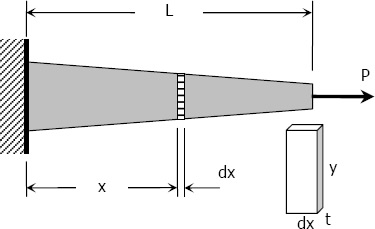Axial Deformation
In the linear portion of the stress-strain diagram, the tress is proportional to strain and is given by
since $\sigma = P / A$ and $\varepsilon = \delta / L$, then $\dfrac{P}{A} = E \dfrac{\delta}{L}$
To use this formula, the load must be axial, the bar must have a uniform cross-sectional area, and the stress must not exceed the proportional limit.
If however, the cross-sectional area is not uniform, the axial deformation can be determined by considering a differential length and applying integration.

where A = ty, and y and t if variable, must be expressed in terms of x.
For a rod of unit mass ρ suspended vertically from one end, the total elongation due to its own weight is
where ρ is in kg/m3, L is the length of the rod in mm, M is the total mass of the rod in kg, A is the cross-sectional area of the rod in mm2, and g = 9.81 m/s2.
Stiffness, k
Stiffness is the ratio of the steady force acting on an elastic body to the resulting displacement. It has the unit of N/mm.
- Log in to post comments
